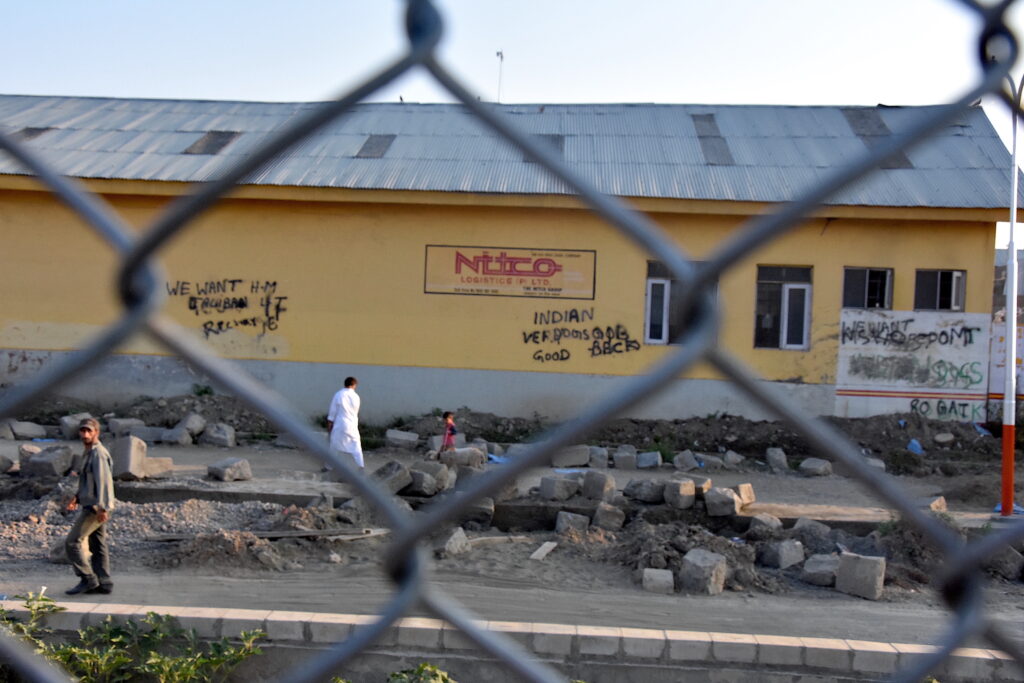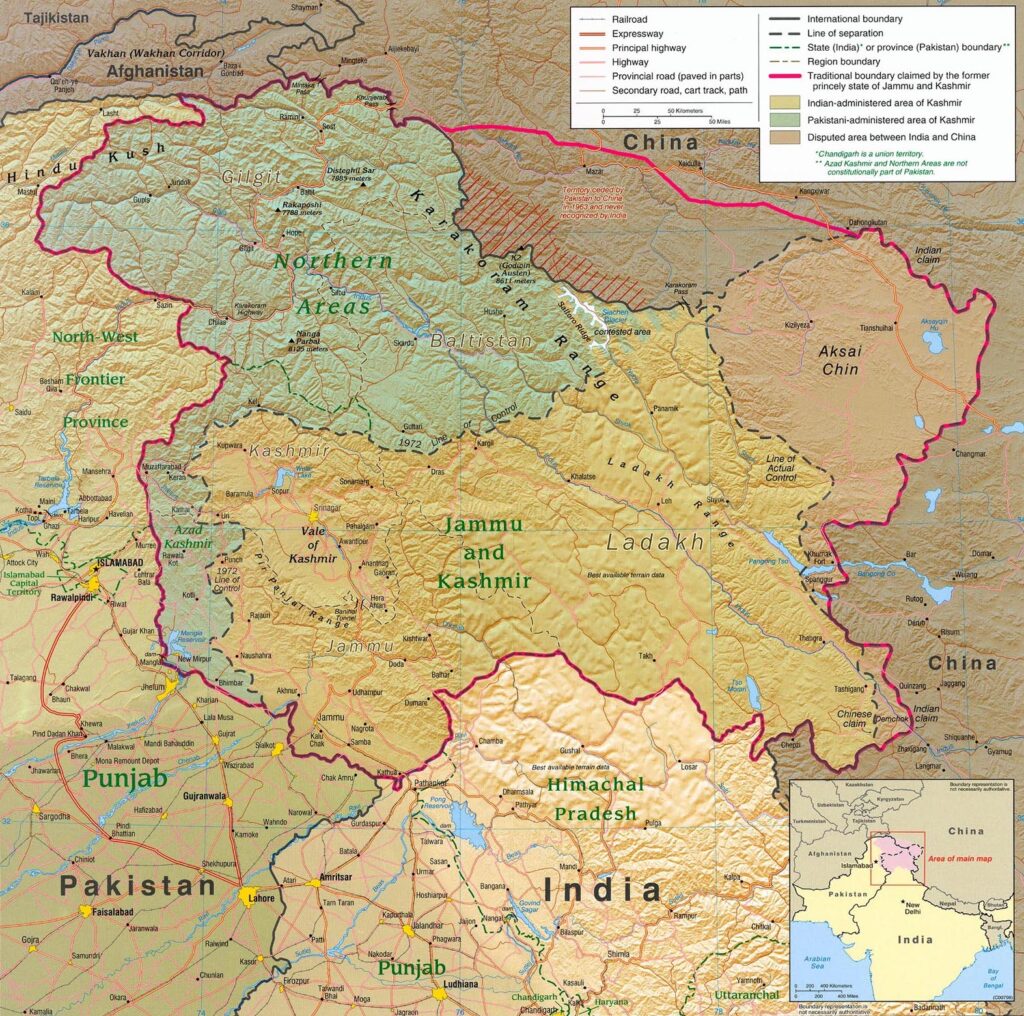Documenting the Kashmir Conflict Through Poetry

“Speak up for your lips are not sealed,
and your words are still your own.
This upright body is yours,
speak while your soul is still your own.”
—Faiz Ahmed Faiz, Pakistani poet
The Valley of Kashmir, cradled in a mountainous Himalayan region, has been shaped by centuries of foreign rule. This place I live in and write from sits occupied and divided between India, Pakistan, and China, a legacy of Britain’s Partition of South Asia. The “Kashmir conflict,” as it is known, has existed between India and Pakistan since the Indo-Pakistan war of 1947. At that time, British authorities left the princely, or native, state’s status undecided, which led to interstate disputes over Kashmir.
Kashmir crumbles under the weight not only of occupation but also of false narratives about our daily lives and motives. Kashmiri people are known to be kind-hearted and soft-spoken. And we have been resisting occupation by the Indian state and its concocted portrayal since 1947. Yet our resistance and fight for freedom is often viewed as anti-state terrorism.
I know this land in my core. My poems connect the dots of our history, memory, and these present times. I explore the associations between sacrifice and freedom that people uphold in Kashmir by resisting Indian militarization and its false agenda of “peace.”
As background to my poems, I share this introduction to briefly explore how Kashmir came to be in its current state. I hope readers can recognize the reality of this place far beyond the dominant narratives and propagandist spins. Perhaps my poems will inspire solidarities with this place and people—connections to make our voices reach across mountains and oceans in a shared fight against repression and injustice.
Join me as I explore everyday life and its moments of delicate emotions of loss, survival, aching tenderness, and possibilities of hope.
WARRING OVER HEAVEN
As a place often referred to as “heaven on Earth,” Kashmir has been fought over by India and Pakistan in three major wars (in 1947, 1965, and 1999) and been the focal point of several skirmishes.
In a nutshell, the Indian government argues the state of Jammu and Kashmir was acceded to India in 1947. This is based on an agreement with the local Hindu Maharaja Hari Singh, who was the ruler of Jammu and Kashmir. However, under the provisions of the Indian Independence Act of 1947, the region was supposed to be acceded to Pakistan as a Muslim-majority state.
The 1947 war resulted in Pakistan occupying one-third of the state (Azad Kashmir and the northern areas of Gilgit Baltistan) and India occupying two-thirds (Jammu, the Kashmir Valley, Ladakh, and the Siachen Glacier). A ceasefire line of 1949 roughly became the Line of Control in 1972. Despite interventions by the United Nations, both countries continue to occupy these regions without the consent of residents—a promised plebiscite on the region’s status so far has never taken place.
During the initial period after 1947, Sheikh Muhammad Abdullah, the founder of the local National Conference Party and the then–prime minister of Kashmir, negotiated with the Indian Congress. He aimed to sustain the region’s autonomy given to it during the time of accession by the Indian state. But his pro-Kashmir reforms led to his expulsion in 1953 by the Jawaharlal Nehru–led government of India, which later resulted in the government eroding Kashmir’s autonomy and ushering in Delhi-made laws.
BORN INTO KASHMIR’S FIGHT FOR FREEDOM, OR AZADI
During the 1980s, as conflict inside the territory intensified, tensions between Kashmiri insurgent groups and the government of India escalated around the issue of local autonomy. Some militants favored Kashmir’s accession to Pakistan, and others fought for Kashmir’s complete independence. Kashmir lacked public infrastructure, and freedom of expression was limited. This resulted in public support for insurgents who advocated for Kashmir’s freedom.
In 1987, elections rigged by the Indian state and the National Conference Party defeated the Muslim United Front and completely changed Kashmiri politics, igniting a public mass movement carried by insurgent groups. As a result, since 1989, there have been protest movements in Indian-occupied Kashmir to voice disputes and grievances, and expose the human rights violations of the Indian government, specifically the Indian military forces.
The turmoil in Jammu and Kashmir has resulted in tens of thousands of deaths of civilians, insurgents, and armed forces both of India and Pakistan.
I was born into this extreme conflict in 1998. In my poem “This Militarization,” I speak of my birth and coming of age in this violence.
Kashmiris have always mounted their voices in popular resistance movements wanting freedom, or “azadi,” but they have been responded to with bullets from the Indian state.
Since 2002, fighting in the region has escalated. Deaths of Kashmiri citizens and leaders at the hands of the Indian government and its army brought widespread protests in the ensuing decades. In 2009 and 2010 alone, more than 120 civilians across the valley were massacred.
Meanwhile, in 2014, the Bharatiya Janata Party, a Hindu supremacist political party, came to power in India under Prime Minister Narendra Modi. It formed its base following the ideology of an Indian right-wing Hindu nationalist organization. Radicalizing this approach, the Bharatiya Janata Party and Modi present India as a Hindu nation (not a secular one) where other minorities live at the mercy of the majority religion.
HINDU NATIONALISTS TARGET KASHMIR
These political changes have severely impacted us in Muslim-majority Kashmir and helped usher in greater repression, new settlements of Indians, and abuses of power. Our nightmares came true as our political identity has been eliminated. We have felt imprisoned inside our homes.
The region had long been on the radar of the Bharatiya Janata Party. On August 5, 2019, the Modi government repealed Article 370 of the Indian constitution, which had guaranteed special status to the state of Jammu and Kashmir. Under this protection, the region had a level of local political autonomy—its own flag and constitution, not only, but also “independence over all matters except foreign affairs, defense, and communications.”
Three days later, the Indian Parliament divided the state and demoted it to two Union Territories of Jammu and Kashmir and Ladakh, respectively, through the Jammu and Kashmir Reorganisation Act.
The Bharatiya Janata Party called the change from statehood to unionization a historical development under the rubric of “integrating” Kashmir with the rest of India. But this constitutional change—recently upheld by the Supreme Court—turned out to mean complete political control over Kashmiri bodies by the Indian military state. We faced one Indian Army soldier for about every 30 people. We still do in 2024.
Moreover, education came to standstill, a complete censorship of media was enacted, and internet and cellphone access were cut off. Many atrocities committed by armed forces went unrecorded. The Indian diaspora remained silent on these war crimes and atrocities committed by its own state.
The U.S. House Committee on Foreign Affairs called for the removal of such restrictions in 2019. Partial internet was brought back in early 2020.
Numerous draconian laws were passed and imposed in the Union Territory to completely change the political and social fabric of the state. These included changes to administrative laws, media laws, land laws, educational policies, and much more.
Freedom of speech and expression have completely been taken away and our voices curbed—voices that try to let the outside world know about life in Kashmir. A mirage of silence looms everywhere.
The out-an-out economic and social collapse of the valley followed, with an increase in mental health cases. My poem “A Long Road Ahead” speaks to this crushing “instability of minds in Kashmir.”
Then when the pandemic hit the region in March 2020, India installed new internet controls and tightened its grip by increasing counterinsurgency operations in Kashmir, killing many militants and their associates. Even the dead bodies were not given to their families, and the state came up with a new draconian tradition of “distant burials” of these militants.
INDIA FORCES SETTLER COLONIALISM
While the Bharatiya Janata Party claims a peaceful and militancy-free Kashmir since 2019, the truth on the ground is completely different. Since 2019, thousands in Kashmir have been detained under laws that allow police officers to apprehend civilians on inadequate evidence. Many such detainees are minors and have been shifted to jails outside of Kashmir.
Internal media continues to be censored. Anyone who voices against the atrocities has been arrested. Civil societies and human rights organizations have been completely shut down in Kashmir. The historic Jamia Masjid mosque in the capital, Srinagar, remains shut for locals to pray. All the separatist parties have been banned and declared as terrorist organizations.
The Indian Army and the government have forcefully taken more land as new colonies are being constructed for settling outsiders in Kashmir to change its demography. As anthropologist Mohammad Junaid pointed out, the recent constitutional changes “opened the doors to Indians to settle in Kashmir, a longstanding demand of the Hindu right wing.”
The unemployment rate reached a high of 23 percent as of March 2023, with many outsiders being posted at different positions in Kashmir rather than local people. Despite some earlier promises of renewing statehood, there is, as of the date of publication, no sign of any democratic elections and elected officials for Kashmir. Kashmiri people are demoralized and reluctant to put themselves at risk. An outside Indian lieutenant governor rules the region.
Again, referencing “This Militarization,” I write about how this massive mobilization by the Indian state to achieve its political objectives and suppress the voices of common people has pervaded the social fabric in insidious ways. It has created a whole generation of disaffected and disillusioned masses who have been facing the social, economic, political, and psychological brunt of the ongoing armed conflict in the valley.
Over the past several decades, armed Indian personnel have unleashed a terror reign on Kashmiris with third-degree tortures, interrogations, sexual violence, raids, extrajudicial killings, fake encounters, and forced disappearances, among other atrocities. The Indian state has been continuously draining the natural resources of Kashmir without providing proper compensation to the Indigenous population. All this has collectively made the lives of Kashmiris miserable and beyond suffering under the Indian occupation whose present lies in ruins.
My poem “Earlier I Had Nightmares, Now I Have Insomnia” reflects this present-day reality.
Although Kashmiris have always mounted their voices in the form of popular resistance movements wanting freedom, or “azadi,” from Indian occupation, they have been responded to with bullets from the Indian state.
Yet the future exists nowhere but in struggle, opposition, and truth-telling. We know freedom will rise over Kashmir one day. As Ghulam Ahmad Mahjoor, one of Kashmir’s great resistance poets of the 19th century, wrote:
“Kashmiris will awaken the East, enlighten it at a destined time;
I will disperse this call into the ears of Kashmiris.”
On the long road ahead, what lies ahead for Kashmir is hope and resilience.
































